8+ Sample Event Photography Proposal
-

Event Photography Proposal Template
download now -
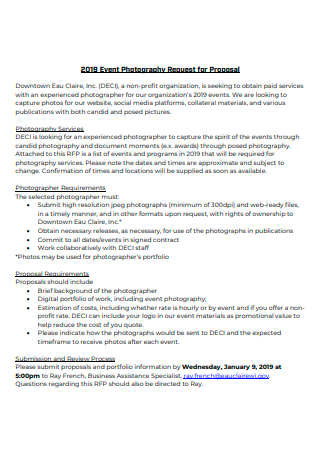
Basic Event Photography Proposal
download now -
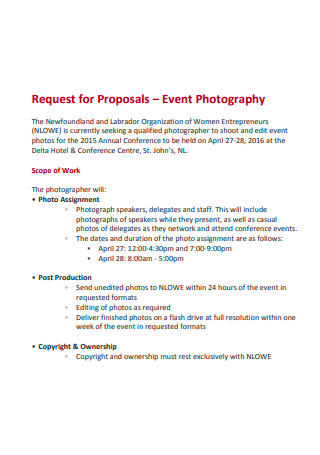
Event Photography Proposal Example
download now -
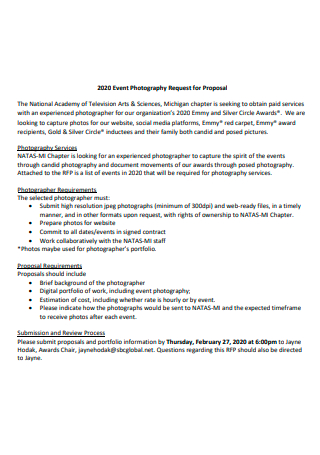
Standard Event Photography Proposal
download now -
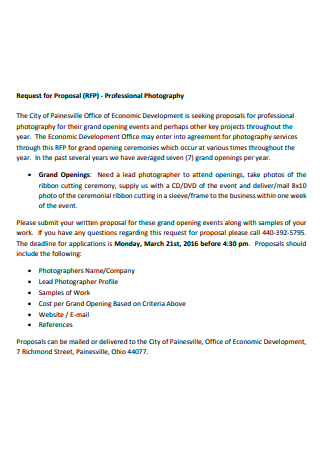
Professional Event Photography Proposal
download now -
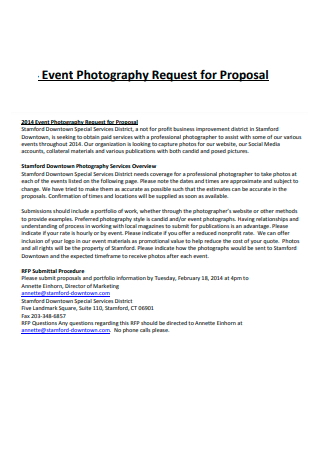
Event Photography Proposal in PDF
download now -
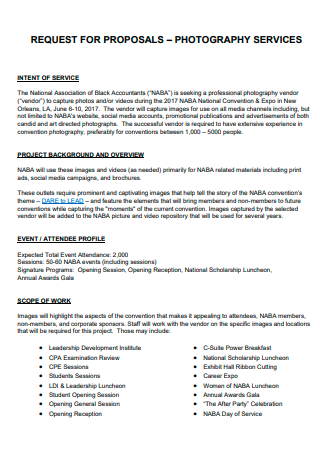
Event Photography Services Proposal
download now -
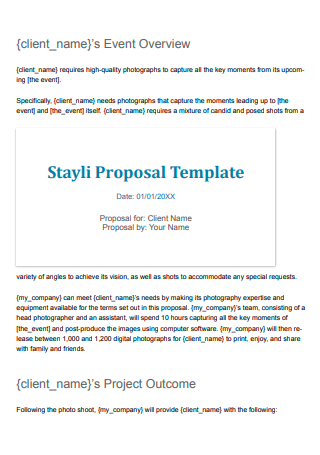
Simple Event Photography Proposal
download now -
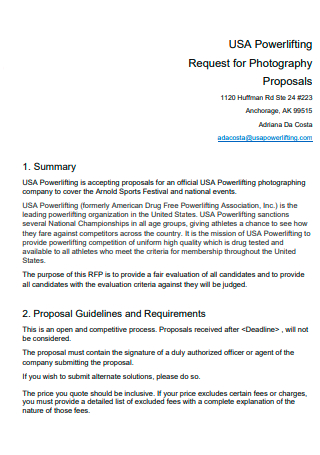
Powerlifting Event Photography Proposal
download now
FREE Event Photography Proposal s to Download
8+ Sample Event Photography Proposal
What Is an Event Photography Proposal?
What Is the Importance of Event Photography Proposal?
What to Communicate to the Photographer?
Types of Event Photography:
What Is the Proper Approach to Photography?
Step To Write an Event Photography Proposal:
FAQs
How do you promote event photography?
How much should you charge in an event photography?
Do you own the images?
What do event photographers do?
Without photography, the world will be irrelevant especially if there is no light and color that opens our minds and expresses art and passion. Therefore, event photography was recognized to keep a record of important events in everyone’s life. Starting with a well-written Event Photography Proposal is the best way to get clients.
What Is an Event Photography Proposal?
Event photography Proposal is a written document that serves as a suggestion or plan to people who are looking for a photographer to cover an event. While event photography is often unnoticed, or at best, a last-minute consideration, still, an event coverage is just as valuable to marketing as any other digital assets. Event photos allows you the opportunity to share your candid moments with your customers. These clients also offer additional advertising material to use for future events, or even just for daily advertising purposes. They are simply shared with participants, allowing you to keep communication open with them even after the event is done. In addition, they give you fresh, new, candid content for your social media or website. Finally, they allow you to create and share blog posts, inviting more visitors to your brand.
What Is the Importance of Event Photography Proposal?
Contracting a photographer for their photography needs will be an assurance to the clients that their special event will be kept in remembrance and will be captured by the talented photographers using superior quality digital cameras. The quality of their photographs is irrefutable and will bring a true image of the event as it was remembered; allowing you to view the images over generations to come.
Moreover, the quality of their photography does not depend on the weather conditions or other external factors that usually alter the image quality. Photographers utilize high resolution digital cameras from various manufacturers.
Additionally, they use hi-resolution digital printers that create high quality photographs that both you and your loved ones will love. Not a single moment of the event will be missed by a professional photographer. With some professional equipment, each person will shine like a star.
What to Communicate to the Photographer?
After hiring your photographer, it is important to include them in the planning as much as possible. Here are some things you should communicate to your photographer, as well as some tips for including them in the planning process.
The Event Timeline. Be sure to incorporate things like when they can arrive to set up, when guests will begin arriving, when would be a good time to take a break, the time of key presentations, and more.
The Shot List: These are the must-have photos. It is very important to discuss your event photography shot list with your official photographer. Without this discussion, it is possible that important people or events will be missed by your photographer. Here is a list of usual requests to help you plan your shot list:
- Details and decorations before guests arrive
- Candid moments throughout the event
- Key presentations and speakers from different angles
- Wide shots of the event and presentations
- Posed groupings and key individuals (someone should help the photographer identify these key individuals and groups)
- Step and repeat option. Think about the red-carpet celebrity style. A step and repeat option often involve a backdrop of something and requires a photographer to photograph groups of people as they enter the event. This is a great way to make sure that guests share their photos after the event.
Attire: How formal is the event? What is appropriate for the photographer/videographer to wear?
Meal Options: Ask the photographer if they have any dietary restrictions. If there are options for plated meals, be certain to ask them what they would like. Providing your photographer with a warm meal is something they will greatly appreciate.
Lighting: Discuss about the environment and what types of lights will be used. Also, it is helpful for the photographer to visit the event space ahead of time, if possible. All these things will let your photographer to then plan their equipment accordingly.
Types of Event Photography:
The event photography specialization that one is probably most familiar with is wedding photography. This is a distinctively important and challenging kind of event photography. For most people, it is an incredibly important day, and they want to be able to look back warmly at their photos for the rest of their lives. Here are some ways that you can concentrate as a photographer for events:
Overall, there is really no limit to the different types of event photography a photographer can specialize in if they can find a market large enough to sustain their career.
What Is the Proper Approach to Photography?
To make sure there is a high-quality output, there is a 6-stage approach to a photography process. Each stage is vital in determining the succeeding step. The six stages are so important in the whole process of photography that is why the clients are the pillar to the survival of the event photography business. Therefore, photographers should request a client to provide feedback whenever they need it.
Survey of the Photography Site
The photographer should conduct a survey to the area that the client wants the photography to take place in. This is as an important step as it determines the right kind of equipment to be used in the process, plus, it also assists the photographer’s team to estimate the costs to be incurred in the whole photography process. Once the site survey is done, the photographer can work smoothly under the various conditions as well as the best cameras that will produce quality photographs in the respective setting.
Agreement On Cost with The Client
After visiting the photography site, the initial costs are adjusted to cover all the costs sufficiently. This will be after the inclusion of travel costs.
Carrying Out the Photography
The photography team travels to the site of photography to cover the events effectively; quality is emphasized through this exercise. All important events are covered adequately by the photography team.
Editing, Storage and Conversion of The Photographs
The photos taken are then edited and converted to various formats that the client may want. Additionally, they will provide a hard copy or transform it to any additional form the client may want.
Delivery And Submitting of Photographs to The Client
The photos are then delivered to the client—this process can be electronic or manual through the website or via snail mail.
Feedback
A photographer will request for feedback on the whole process from the client and the information they get is used to improve their service delivery process.
Step To Write an Event Photography Proposal:
Running a photography business would need you to be more than just a great photographer. With the growing number of digital photography, it is safe to say that the photography industry has become extremely competitive. Unexpectedly, everyone is a photographer, and you must go the extra mile to stand out in a crowded market.
One of the ways to attract your prospective clients is by writing a convincing business proposal that positions you to be well-suited for the project and helps you close deals. Take a look at how you can write an amazing event photography proposal that lands clients:
Step 1: Design a Cover Page
You are expected to have a creative mind and that needs to be reflected across every section of the photography proposal as a photographer. The cover page is the first thing your clients will check out and, in many ways, it sets the tone for the rest of the proposal. Therefore, it is essential to design a stunning cover page that echoes what your business is about while being neatly laid out and appealing.
The most important elements of the cover page include: the title of your photography proposal, the company name, business logo, and background image. It is also a good idea to choose a theme for the proposal. This helps you stick to a consistent color scheme and typography in the entire document.
Step 2: Showcase Your Portfolio
While you can write a lot about your business, what your clients are really interested in is your past work. Use this space to showcase your portfolio and show your abilities. Creating a portfolio is not about just compiling your past work. The key lies in the ability to select the right pieces of work that will appeal to the client you’re sending the proposal to. Most photographers tend to treat their portfolio as a dumping ground for as much work as possible with the intention that quantity is the key to building their credibility. Oftentimes, the opposite is right. So, try to understand your target client and the project you are pitching for before you include your past work.
Step 3: Detail Out Your Services
You are well-aware that your services do not end at taking photos. There’s a lot of work that goes before and after the photoshoot.
For example, some of the services include:
- Pre-production or strategy meetings
- Half-day or full-day photoshoots
- Studio or location setup
- Post-production: photo editing, color corrections and retouching
- Photo delivery
Detailing out your services truthfully gets everyone on the same page while letting your clients get an overview of everything you can offer. It is a good idea to use visuals in the form of infographics, illustrations or icons to visually communicate this section so that it’s easier for your clients to scan and read it.
Step 4: Explain Your Working Process
It is extremely important to outline the project roadmap, deliverables, and timelines—in addition to introducing your prospective client to your company and the services you offer. The idea behind this is to demonstrate your way of working and set expectations upfront. It shows proactiveness and attention to detail on your part while helping clients get a deeper understanding of how you plan to structure the project. The most effective way to communicate this is by visualizing your project plan. This gives clients a quick overview of the project and aids decision-making.
Here are some visual tactics to use in order to explain your working process:
- High-level roadmap to show the evolution of the project over time
- Simple project management timeline, outlining the major events or deliverables
- Gantt chart to highlight the key tasks, team members and timelines
Step 5: Include Social Proof
It is interesting to note that 84% of people trust online reviews just like personal recommendations. This shows how powerful social proof is—making it a must-have in your photography proposal. Social proof helps build credibility as it serves as third-party validation. When prospective clients see what your past clients have said about you, it gets easier for them to trust your services and expertise.
Here are the different types of social proof you can include in your photography proposal:
- Client reviews and testimonials
- Marketing case study
- Awards and recognition
- Logos or names of clients you have worked with
Step 6: Share Pricing and Payment Terms
At the end of every business proposal, clients will want to know what your services are cost. This can be a tricky section because a poor pricing strategy is expected to drive clients away. But it still depends on how you present your pricing structure and payment terms. Take note that some clients say no to a proposal not just because of sticker shock, but because of the way the price was presented or explained to them.
It is a better idea to present your client with payment options, thereby giving them some room to consider it. You can use a price comparison table to show the different pricing structures along with what they include.
FAQs
How do you promote event photography?
Event photography is advertised or promoted by creating a social media, building a website, creating a portfolio, having referrals, getting the works displayed, becoming a 2nd shooter of an established photographer, and making a good connection and relationship with people.
How much should you charge in an event photography?
The average cost for an engagement photographer is $200 per hour. So, hiring an engagement photographer to capture your big day will likely cost between $100 and $300 per hour. The price of engagement photography can differ greatly by area.
Do you own the images?
A photographer may like to feature some of their favorite images from an event on their website. Ownership of the images from a conference is determined on a case-by-case basis. However, there are times when images from a conference may not be appropriate to share, and for this reason, there is a flexible ownership and use of images.
What do event photographers do?
Events photographer specializes in taking pictures for important or specific gatherings such as parties, shows, events, and weddings. They must assist with the event setup and provide excellent customer service to make sure that things will run smoothly before, during, and after the event.
Photographers take photographs for a variety of events including parties, weddings, engagement, gender-reveals, funerals, outings, and picnics as well as emergency situations like accidents and crime scenes.
Photography is an art, but people take photographs for many reasons. Photos can also be taken to serve as proof on how something happened. It lets the viewer experience comparable emotions and feelings the photographer had. Whether you are a freelancer or running a photography business, what is essential is positioning yourself as the expert and selling your services as such that it appeals to your target client.
